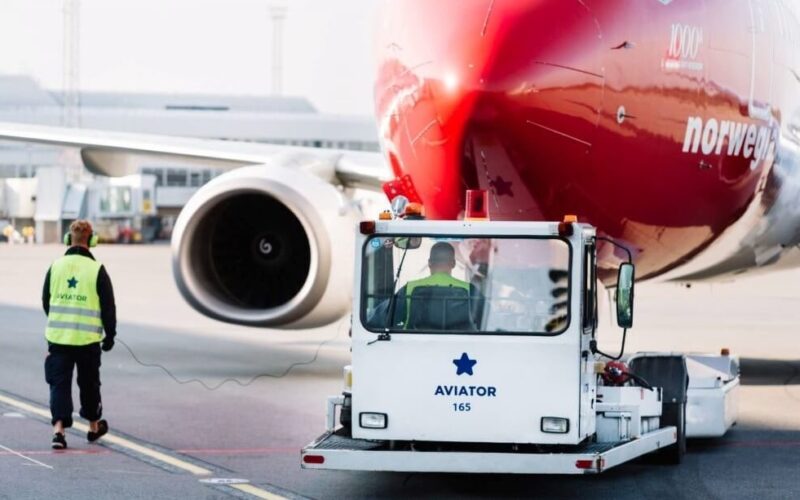When talking about risk-involving careers, the first thing that comes to mind is firefighting, police work, or high-rise window washing. But there are many more jobs that have lots of risks and challenges involved. Aviator Airport Alliance, a full-range provider of aviation services at 15 airports across the Nordics and a family member of one of the largest global aerospace service groups Avia Solutions Group, shares the thrilling, yet risky parts of their teams’ day-to-day operations.
“Working in the field of ground handling exposes you to a wide range of hazards, many of which are unique to airports,” shared Ola M Bakk, Corporate Safety and Compliance Manager at Aviator. “There are many things which you need to consider making sure you can work safely and avoid hurting yourself, your colleagues or even aircraft passengers or crew, at all locations handling air traffic, especially on the ramp.”
The gravity of the operations
“Our ramp staff has substantial responsibilities not only over the safety of themselves or their colleagues but also over assets such as aircraft, equipment, passengers and crew. It’s a very responsible position to be in. We routinely operate sophisticated ground equipment, worth up to and more than 1 million euros that can also weigh several tons and be quite complicated to work with. Additionally, such equipment is operated close to aircraft which can have a price tag of 250 mill euros,” Bakk talked about the financial aspect.
“Most commercial aircraft that we see fly today have a skin thickness between 1.70mm to 2.20mm depending on the location on the fuselage. A scratch on the aluminium plates on the fuselage with a depth of only 10% of the thickness can lead to a fatal accident,” he shared. “During a turnaround, as many as 10 vehicles of various sizes and functions are involved and in a short period, these approach the aircraft several times. A small error during operations could leave the aircraft unfit for flight. Even worse, if a contact is not detected or reported and the aircraft leaves, it could jeopardise the safety of hundreds of passengers and crew. In addition, during the winter season, our staff is responsible for removing ice and snow from aircraft. Without this process, the aircraft would not be able to lift off safely.”
The many risks of working on the ramp
According to Bakk, the most serious hazards associated with working at airports for an individual are encountered on the ramp, which one should not work on or cross unless necessary and with the correct training. “Hazards could be anything from moving aircraft or vehicles, aircraft engines and propellers, aircraft noise and all other general risks such as slips, falls and extreme weather.”
A ramp worker is exposed to all of those threats during a normal day at work and, to some extent, they also work in heights. “A fall from a hi-loader could lead to fatal consequences,” he explained. “While at the job, ramp workers must remain attentive to their surroundings as, for example, during push-back operations, they walk, fairly unprotected in an area with moving aircraft, with engines running and vehicles moving. A step in the wrong direction and they can get run over or be hit by a vehicle or aircraft. There is also the risk of getting into the engine danger areas, which would be fatal,” he added.
Aviator’s Corporate Safety and Compliance Manager told that all those threats and hazards are risk-assessed and then mitigating actions are introduced. “This could be hard barriers, such as Personal Protective Equipment (PPE) and safety devices on equipment, or soft barriers, for example, procedures and routines.”
Taking safety precautions
Aviator has many procedures and measures in place to ensure the safety of their ramp employees. Some simple measures include bright high-visibility clothing, ensuring that all staff can be seen by anybody that needs to see them.
“Hard barriers, such as protective equipment and safety devices, are only half the battle won,” said Ola M Bakk. “The staff are also required to follow our procedures and routines to the letter, which helps to reduce the potential for hazardous scenarios.”
The soft barriers Aviator introduces to reduce all hazards and risks, is a thorough training and detailed procedures that must be known and adhered to by all staff.
“For example, part of the basic training is apron safety. In this training, all staff will be introduced to all the hazards they could encounter ramp side. We always put a huge emphasis on what we call ‘situational awareness’. All our ramp workers must be able to recognise any possible issue once they arrive at the scene and act proactively to avoid a negative impact. More easily, this means that you need to know what you are doing and what is going on around you,” he explained.
Bakk mentioned that the procedures and routines available for ramp staff are developed and improved over time. “The safety office reviews all procedures on a frequent basis. If there has been an incident during operations, the applicable procedures are also reviewed to see if there is a need for a revision to raise the level of safety and ensure that reoccurrences do not happen. All operations on-ramp, and the airport in general, have documented associated procedures, describing each operation in intricate detail. These documents also describe the requirements for equipment and training to perform the operation in the safest possible way,” he said.
In case of any safety-related occurrences, thorough and detailed investigations are done. “When we find the root cause, we take action to eliminate a reoccurrence. Such actions can include equipment modifications, procedural or training material updates, or retraining of staff,” Ola M Bakk explained.
So, is it possible to ensure work safety at airports? “Our well-trained and dedicated staff ensures safe flights, all year round, with a high level of responsibility to both assets and life,” Ola M Bakk, Corporate Safety and Compliance Manager at Aviator, confidently said.

